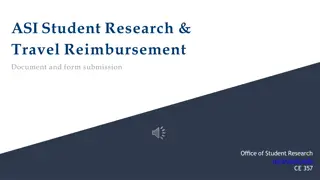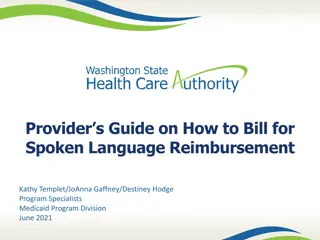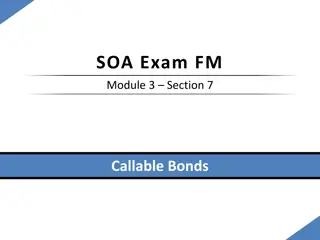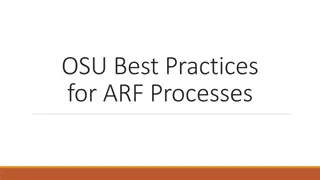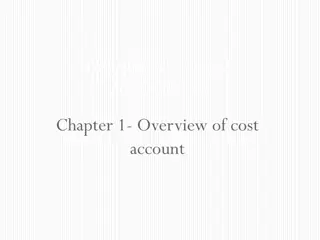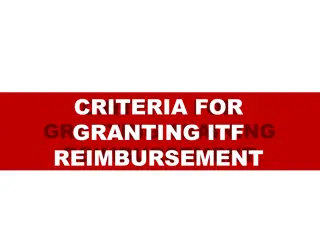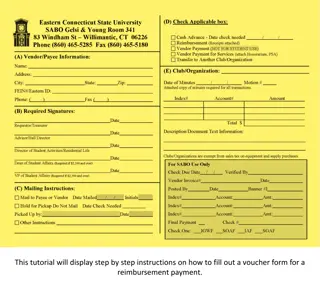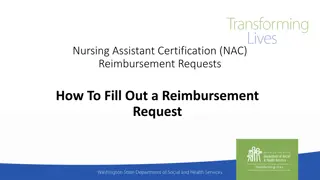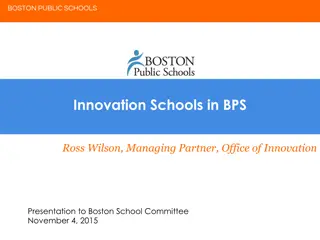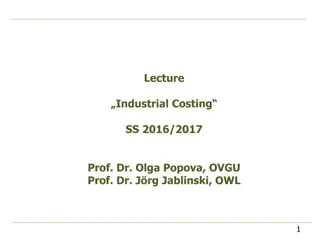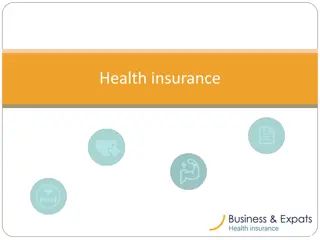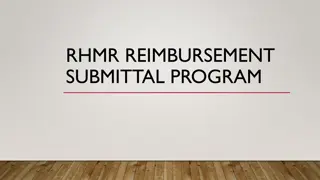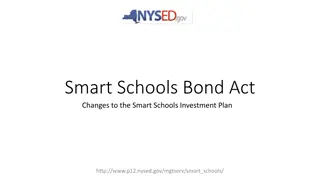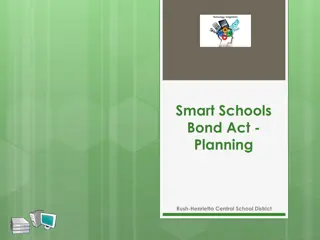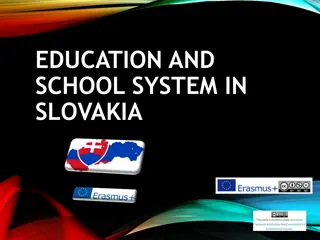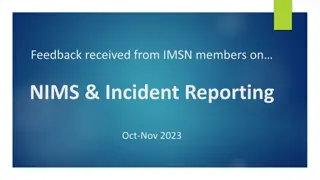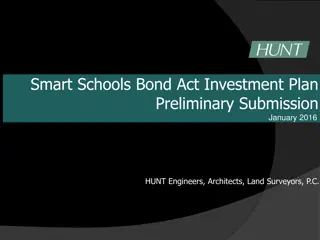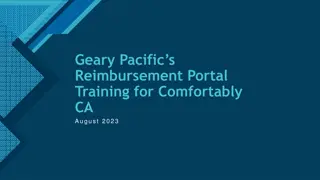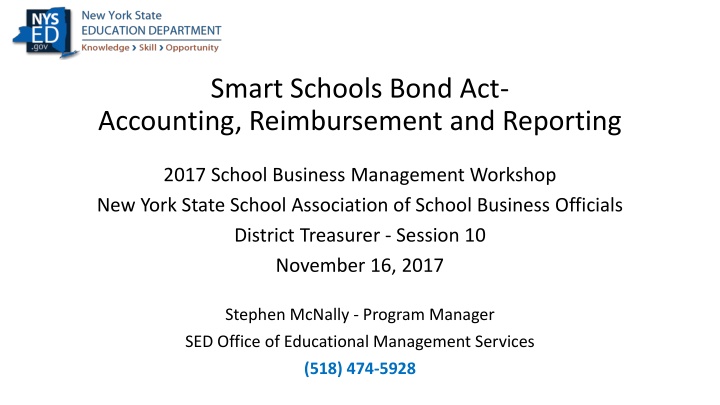
Smart Schools Bond Act - Accounting, Reimbursement, and Reporting Update
Dive into the latest updates on the Smart Schools Bond Act, including accounting for funds, new reserve fund reporting, upcoming program changes, and common reimbursement claim issues. Explore the status of investment plans and reimbursement claims, along with key insights shared at a recent school business management workshop. Stay informed and navigate the complexities of managing Smart Schools programs effectively.
Download Presentation

Please find below an Image/Link to download the presentation.
The content on the website is provided AS IS for your information and personal use only. It may not be sold, licensed, or shared on other websites without obtaining consent from the author. If you encounter any issues during the download, it is possible that the publisher has removed the file from their server.
You are allowed to download the files provided on this website for personal or commercial use, subject to the condition that they are used lawfully. All files are the property of their respective owners.
The content on the website is provided AS IS for your information and personal use only. It may not be sold, licensed, or shared on other websites without obtaining consent from the author.
E N D
Presentation Transcript
Smart Schools Bond Act- Accounting, Reimbursement and Reporting 2017 School Business Management Workshop New York State School Association of School Business Officials District Treasurer - Session 10 November 16, 2017 Stephen McNally - Program Manager SED Office of Educational Management Services (518) 474-5928
Todays Topics Smart Schools Bond Act Program Update Accounting for Smart Schools Bond Act Funds New Reserve Fund Reporting on the 2018-19 Property Tax Report Card Upcoming Changes to the Program New Smart Schools Investment Plan (SSIP) Form for applications after 4/15/17 Additional Nonpublic Loan Sharing to include certain School Connectivity items New Nonpublic category in both the SSIP and the Reimbursement System 2
Smart Schools Investment Plans Status - Summary 461 plans approved or ready for approval by the Review Board with budgets totaling $1,178,505,715 including: 321 school districts, (includes multiple SSIP projects) All Big 5 districts 20 Special Education schools Approved in six previous Review Board meetings: 374 plans for 280 school districts and 13 Special Education schools, totaling $320,762,896 87 plans at Review Board ready for approval, with budgets totaling $857,742,819. $783 million of this is from two NYC Smart Schools Investment Plans (SSIP s) There are an additional 239 SSIP s in various stages of internal SED review. 3
Reimbursement Claims Submitted/Paid Summary as of 11/10/2017 245 claims with budgets totaling $107,026,246 including: 148 School Districts 3 Big 5 Districts: Rochester, Syracuse & Yonkers 229 claims approved, totaling $95,906,055 168 School Districts = $81,071,165 2 Big 5 Districts = $14,835,890 Total pending claims = 16, totaling $11,120,191 4
Common Issues with Reimbursement Claims Lack of concordance between approved SSIP budget and items being claimed. Claiming expenditures under the wrong sub-subcategory. Such as Interactive Whiteboards vs. Other Costs Projectors Multiple expenditure items rolled up , instead of detailed. Lack of detailed description of an item, which makes it difficult to review and confirm pricing. Include make and model number, where appropriate. Missing the company or individual name for professional services. Remember to clear all pending claims before filing an amendment or supplemental SSIP. 5 5
Related Expenditure Reimbursement FAQs How do you access the reimbursement system? Through the SED Business Portal under SSBA Reimbursement application. Where do I submit documentation of the expenditures? Districts will not need to send invoices or other documentation to SED, unless questions arise. However, districts must keep all documentation of expenditures including receipts, on hand for audit purposes. Why are some categories in the reimbursement system grey and not allow me to add claims? The district does not have an approved budget within that category. How can we file for reimbursement of items that have been modified or changed since approval? Significant changes between your approved budget and actual expenditures may require you to submit an amendment to the original amended SSIP. 6
Related Expenditure Reimbursement FAQs What counts as a significant change ? Purchasing substantially different or additional items than listed on the approved SSIP Expenditure Table. Such as, changing from laptops to desktops or tablets, or changing from one operating system platform to another, such as Dell to Apple or vice-versa. Purchasing many more or less of one or more approved items, other than due to price increases or decreases. Large increases in item costs from what were approved in the original SSIP. Generally, expenditures that change the overall purpose or project(s) from what was approved in the original SSIP. Districts should contact the Smart Schools Office as soon as they become aware of the issue. Send an e-mail to: Smartschools@nysed.gov 7
Accounting for Smart Schools Funds How will SSBA funds be accounted for? In the General Fund, Special Aid Fund or Capital Fund? School districts will be required to identify these funds separately within their current financial accounting framework. The school district annual financial reporting document, the ST-3, has been updated with a new capital revenue code, H3297 State Sources, Other (SSBA). Use existing expenditure account codes for Smart Schools Bond Act funds. School districts will be required to separately identify these expenditures within their current financial accounting framework. Existing Schedule G3 Capital Projects Fund codes should be used. Districts should create new account codes by adding 'SSBA' or a specific 4- digit code to the end of the expenditure's account code to distinguish SSBA from the rest of the Capital Fund's account code. 9
Accounting for Smart Schools Funds Where should SSBA capital expenditures be reported in the ST- 3? A: On Schedule G3 where Capital Fund expenses are reported. Districts should use the following accounts: Account SSBA Categories Regular School: Furniture, Equipment, Textbooks Classroom Technology, Pre-K, TCU Replacement General Construction: HVAC, Plumbing, Electric, Site Improvement, Utility & Service School or Community Connectivity, High Tech Security, Pre-K, TCU Replacement School or Community Connectivity, High Tech Security, Pre-K, TCU Replacement Buildings Superintendent of Construction or Clerk of Works School or Community Connectivity, High Tech Security, Pre-K, TCU Replacement Contractual and Other: Architecture, Legal, Engineering and Insurance School or Community Connectivity, High Tech Security, Pre-K, TCU Replacement 10
Related Smart Schools Bond Act FAQs Do the capital projects under SSBA require voter approval? Not if funded solely with SSBA funds and do not include debt financing. Are capital expenditures under SSBA counted in calculating our capital exclusion under the Property Tax Cap? No. Districts should not include SSBA-funded expenditures in their Tax Cap calculations. How should our district fund the upfront expenditures, prior to reimbursement? RANS, local tax revenues or other sources. Interest costs are not eligible for reimbursement. Shouldn t need to, as expenditures can not be made before Review Board approval and multiple reimbursement claims can be filed and paid quickly. 11
New Statutory Requirement to Include a Schedule of Reserves on the Property Tax Report Card (PTRC) 2017-18 State Budget included new requirements regarding School District Reserves, including: Board approval by resolution for any transfers into reserves. Development of a Schedule of Reserves as of 3/31 each year. A narrative description of the intended use of each reserve in the next fiscal year. Inclusion of the Schedule of Reserves in the Property Tax Report Card, and Appended to the Annual Budget Document presented to the public. 13
2018-19 Property Tax Report Card 000000 - DISTRICT NAME Contact Person: Budgeted Proposed Budget Percent Telephone Number: 2017-18 2018-19 Change (A) (B) (C) Total Budgeted Amount, not Including Separate Propositions % A. Proposed Tax Levy to Support the Total Budgeted Amount 1 B. Tax Levy to Support Library Debt, if Applicable C. Tax Levy for Non-Excludable Propositions, if Applicable 2 D. Total Tax Cap Reserve Amount Used to Reduce Current Year Levy, if Applicable E. Total Proposed School Year Tax Levy (A + B + C - D) % F. Permissible Exclusions to the School Tax Levy Limit G. School Tax Levy Limit , Excluding Levy for Permissible Exclusions 3 H. Total Proposed School Year Tax Levy, Excluding Levy to Support Library Debt and/or Permissible Exclusions (E - B - F + D) I. Difference: (G - H); (negative value requires 60.0% voter approval)2 Public School Enrollment % Consumer Price Index X.XX% 1 Include any prior year reserve for excess tax levy, including interest. 2Tax levy associated with educational or transportation services propositions are not eligible for exclusion under the School Tax Levy Limit and may affect voter approval requirements. 3For 2018-19, includes any carryover from 2017-18 and excludes any tax levy for library debt or prior year reserve for excess tax levy, including interest. Actual Estimated 2017-18 2018-19 (D) (E) Adjusted Restricted Fund Balance Assigned Appropriated Fund Balance Adjusted Unrestricted Fund Balance Adjusted Unrestricted Fund Balance as a Percent of the Total Budget % %
NEW SCHEDULE OF RESERVE FUNDS (CHAPTER 514) 3/31/18 Ending Balance Reserve Name Capital (Including Transportation) Reserve Description * To pay the cost of any object or purpose for which bonds may be issued. Intended Use of the Reserve in the 2018-2019 School Year Employee Benefit Accrued Liability For the payment of accrued employee benefits due to employees upon termination of service. To pay liability, casualty, and other types of uninsured losses. Insurance To establish and maintain a program of reserves to cover liability claims incurred. Liability Mandatory Reserve for Debt Service To cover debt service payments on outstanding obligations after the sale of district capital assets. To establish and maintain a program of reserves to cover property loss. Property Loss To pay the cost of repairs to capital improvements or equipment. Repair Reserve for Insurance Recoveries To account for unexpended proceeds of insurance recoveries at the fiscal year end. Reserve for Tax Reduction For the gradual use of the proceeds of the sale of school district real property. Retirement Contribution To fund employer retirement contributions to the State and Local Employees Retirement System To establish a reserve fund for tax certiorari settlements Tax Certiorari Unemployment Insurance To pay the cost of reimbursement to the State Unemployment Insurance Fund. Workers Compensation To pay for Workers Compensation and benefits.
Suggestions for the Schedule of Reserves Use best estimates of what balances will be at 3/31/18. Include interest earned through 3/31/18. Be aware of Board actions to establish new reserves or provide additional funding. For description of planned use, be brief but specific about what it will be used for in the upcoming year. List the proposed appropriation in the 2018-19 budget. Mention if any capital expenditures will need to be voted upon in the upcoming May Budget Vote. 16
New Program Rules Enacted in 2017-18 2017-18 State Budget changed the rules for the calculation of the nonpublic share amount. A portion of School Connectivity investments will now be part of the per-pupil calculation of the nonpublic loan amount. For districts with School Connectivity investments that had submitted or approved plans prior to April 15, 2017, the Legislature and Governor created a supplemental $25 million program to provide districts with the difference between their original calculated nonpublic loan amount and the additional loan amount generated under the new rules; 18
New Program Rules Enacted in 2017-18 NYSED will notify both eligible districts with approved SSIP s and eligible nonpublic schools of the new funds shortly after the Review Board approves new guidance; Every eligible district will be expected to access the funds to purchase and lend additional eligible items to the nonpublic schools in their district. Eligible districts will not need to amend existing SSIP s, whether already approved or pending review. School districts will simply claim reimbursement of the new amounts to support the loans in the existing SSBA Reimbursement System on the Business Portal. 19
New Program Rules Enacted in 2017-18 For districts with plans submitted after April 15, 2017, the Smart Schools program and application (SSIP) itself will change subject to the same calculation rules. The nonpublic per pupil calculation will grow; however, The per pupil loanable share will remain capped at $250. When the Review Board approves the updated guidance, districts that have submitted since April, and have nonpublic schools in their district and have loanable items under the School Connectivity category, will have their plans unsubmitted by SED to reflect the change, but they will remain in the review and approval queue in the same place. 20
How has the Nonpublic Share Calculation Changed? Before, only items in the Classroom Technology category were included in the total amount that was divided by the total public and nonpublic 2014-15 enrollment to calculate the per pupil loan amount. Now, certain movable items in School Connectivity will be included. New SSIP will pre-fill public and nonpublic 2014-15 enrollments. Districts will break out budget sub-allocations between loanable (movable) and non-loanable School Connectivity amounts. These include: 21
Additional School Connectivity Items Included in the Revised Nonpublic SSBA Loan Calculation Storage devices Routers/Gateway Appliances Firewalls/Security devices Switches Wireless Access Points and Attached Antennae Controllers Modules Transceivers 22
School Connectivity Items Not Included in the Revised Nonpublic SSBA Loan Calculation Cooling Appliances Hardware Extended Warranties Licenses/Software Cabling/Fiber Appliance and Network Configuration These are not considered transportable items, but operational costs for the nonpublic school to pay for with their own funds. 23
Smart Schools Bond Act QUESTIONS? Smart Schools Bond Act Website: http://www.p12.nysed.gov/mgtserv/smart_schools/ Smart Schools Bond Act Email Box: smartschools@nysed.gov SED Office of Educational Management Services (518) 474-5928 24

